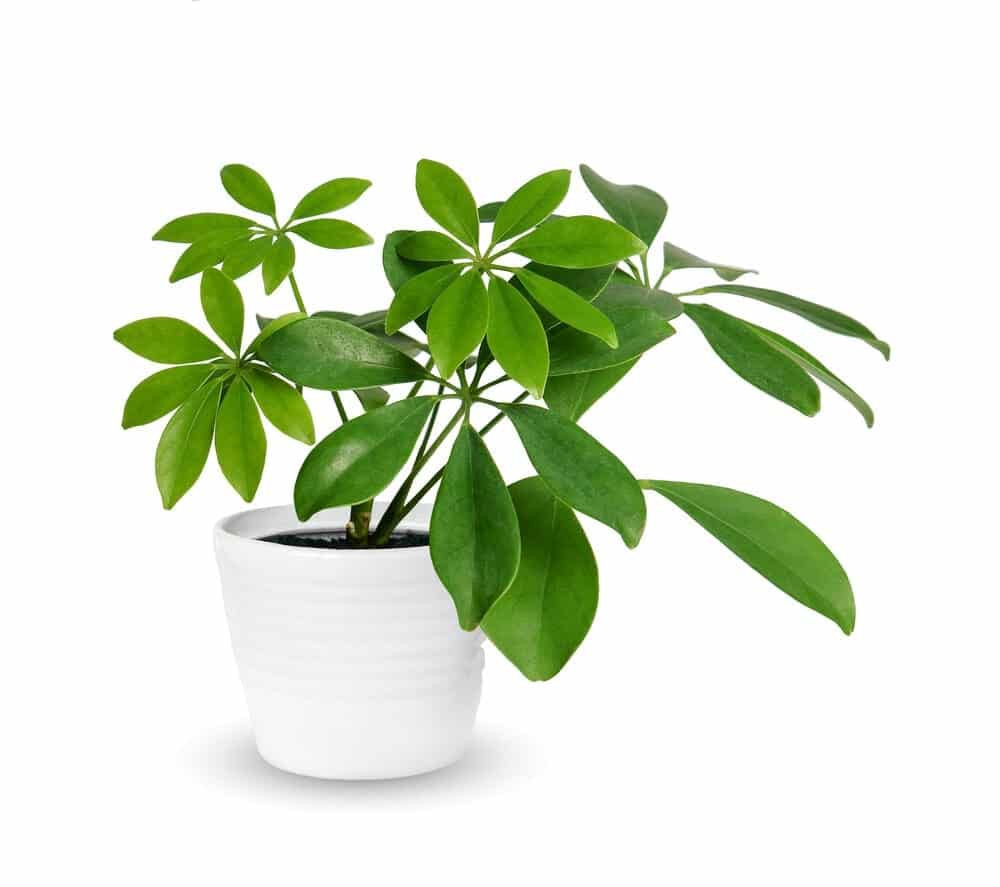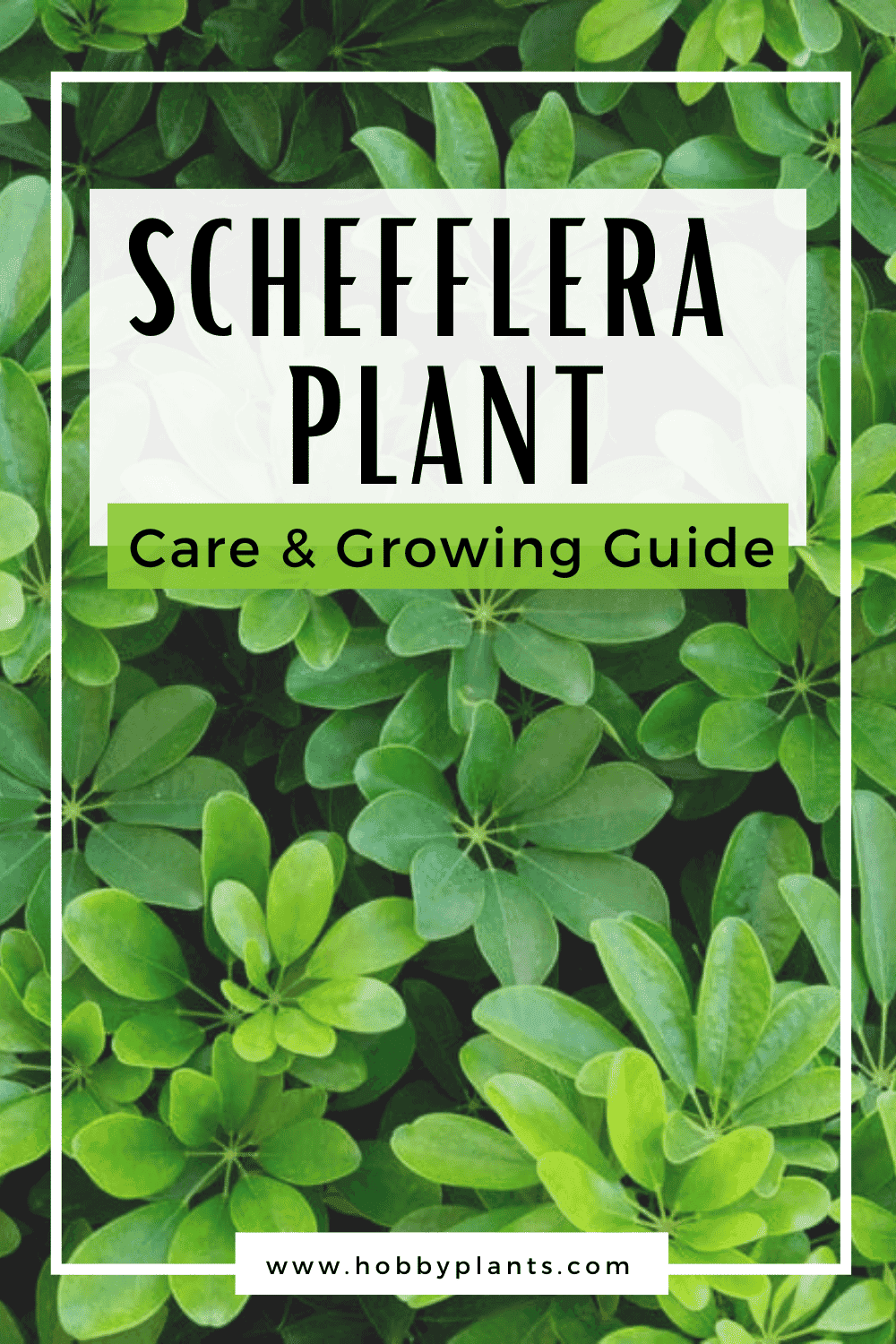This is one of the most popular indoor plants to grow. It is well known for its hand-shaped, decorative, variegated, shiny leaves.
One of its functions is being used as a natural room freshener. It is originally from the South of China and Taiwan. As a house plant, it grows laterally as an evergreen shrub, but can also be grown as a climber.
Schefflera Plant Care & Growing Guide
1. Light Requirement
The best place to place your Schefflera plant is in a light to a semi-shaded area of your home. The area should also be draft-free. Avoid exposure to direct sun. In the summer, it needs to have suitable shading because the direct sunlight can burn the leaves. It is best if it has some sun in the morning and evening. In the summer, you can put it in a semi-sunny place outside. Make sure that the plant is turned toward the light so the plant will remain leafy
2. Water
During the growing season, which is April to September, you should water it moderately. Allow the upper layer to dry to about an inch before you pour water on it. It has had enough water when the first drops come out of the drain holes. If you have your planter sitting in a saucer, empty the water from it after giving it a couple of minutes to drain out the excess water.
If the air is too dry, you should spray the Schefflera plant often as they like a room with humidity of 60-70 percent. When you water or spray the plant, only use lukewarm water.
3. Climate
USDA Hardiness Zone 10-11
4. Soil
The best soil for the Schefflera plant should consist of two to three parts soil, four parts clay, 0.5 part quartz sand, and one part pumice gravel, lavalit, or lava granules. The pH should be 6.0-6.5 and slightly acidic. You can adjust the balance by adding more or less arable soil with clay.
5. Temperature
During the day, the best temperature for a Schefflera plant would be 75-80 degrees Fahrenheit and at night, 65-70 degrees Fahrenheit. To make sure that the temperature stays in the correct range, you can put a thermometer near the plant. If it is too cold, it will cause the plant to lose its leaves.

6. Repotting
When you repot your Schefflera plant you do not need to fertilize it for eight weeks. Generally, it will only have to be repotted every two-three years. When the roots are sticking out the top or bottom of the planter, it is time to repot it. The best time to repot a Schefflera plant is in the spring after it has wintered.
Carefully take the plant out of the pot and remove the old soil. Put drainage of coarse gravel in the bottom of the new pot to make sure that it is going to drain well. Put a piece of fleece between the gravel and soil and the drainage. Put the fresh soil mixture on top. Put the plant inside and fill it with soil, pressing it down slightly and then water it well.
7. Speed of Growth
If they are grown in the right conditions, they can grow three feet each year.
8. Height and Spread
The Schefflera plant can reach 12-15 feet tall at maturity. For indoor plants, you can get ones that only grow a foot or two.
9. Flowers
The flowering period for the Schefflera plant is July to October. When in a planter, it will usually not flower. In its natural habitat, it would produce red, colorful flowers.
10. Trimming
In order to help combat the height, giving the growth a bushy look you will need to do a cut back periodically. If you do not do this, you could end up with a plant that looks shabby and bald. You should do your trimming in the spring, but no later than May. If there are long shoots, you can shorten them by two-thirds. When you occasionally cut the shoot tips, it will help to promote new side shoots to grow. When trimming, make sure that you are always cutting above the leave buds.
If you see a knotted joint on the trunk, that is what is going to form a bunch of new shoots. You should always remove any limp or diseased plant parts.
Is Schefflera Plant Poisonous?
All parts of the Schefflera plant are poisonous to animals and humans so you should wear gloves when handling the plant.

Can Schefflera Plant grow in Water?
Yes, you can start cuttings in water and as soon as they start to grow roots, they can be planted.
How to get Schefflera Plant to Flower?
The Schefflera plant generally will not flower when it is grown as a houseplant.
Also read: Umbrella Plants Care & Growing Guide
Common Plant Diseases
Schefflera Plant is prone to a variety of diseases, including:
- Root rot—this is a fungal infection that is caused by too much moisture. If you catch this in time, the plant should live. You can tell your plant has root rot by a rotten smell in the substrate or yellow leaves. To save the Schefflera plant, you have to take it out of the pot, remove the soil along with all the rotten plant parts and roots. Then you need to repot it with fresh substrate.
- Scale insects, like aphids, mealy bugs—these occur because the growing conditions are not favorable. You can rub the leaves with a cotton ball dipped in rubbing alcohol or spray the leaves with a soapy water mixture.
- Spider mites—this is one of the greatest enemies of the plant and it is generally caused because the Schefflera is not getting enough water. You can also use the soapy water mixture to spray on the leaves to get rid of them.
More like this:
Conclusion
- As a natural air freshener, the leaves release oxygen and absorb pollutants like formaldehyde and benzene.
- To help preserve the shine of the leaves, you should occasionally use a damp cloth to wipe off the leaves.
- To make sure that it is getting the right nutrients, you should fertilize it from spring to fall. Use a normally dosed fertilizer once or twice a week.

Victoria is the owner and main author of hobby plants. She loves spending her free time in her garden planting and taking care of her plants. Victoria hopes you enjoy the content here!
![Mother Of Thousands Plant [Complete Plant Care Guide] Mother Of Thousands Plant [Complete Plant Care Guide]](https://www.hobbyplants.com/wp-content/uploads/2022/07/mother-of-thousands-plant-300x158.jpg)
![Majesty Palm Plant Care: [Complete Beginner's Guide] Majesty Palm Plant Care: [Complete Beginner's Guide]](https://www.hobbyplants.com/wp-content/uploads/2022/08/majesty-palm-care-300x158.jpg)
![Exotic Angel Plant Care: [Complete Beginner's Guide] Exotic Angel Plant Care: [Complete Beginner's Guide]](https://www.hobbyplants.com/wp-content/uploads/2022/08/exotic-angel-plant-care-300x158.jpg)
![Snow White Waffle Plant: [Complete Care Guide] Snow White Waffle Plant: [Complete Care Guide]](https://www.hobbyplants.com/wp-content/uploads/2022/08/snow-white-waffle-plant-300x158.jpg)
![Waffle Plant Care: [Complete Beginner's Guide] Waffle Plant Care: [Complete Beginner's Guide]](https://www.hobbyplants.com/wp-content/uploads/2022/08/waffle-plant-300x158.jpg)
![Bird Of Paradise Plant Care: [Complete Beginner's Guide] Bird Of Paradise Plant Care: [Complete Beginner's Guide]](https://www.hobbyplants.com/wp-content/uploads/2022/08/bird-of-paradise-plant-300x158.jpg)
![Purple Passion Plant Care: [Complete Beginner's Guide] Purple Passion Plant Care: [Complete Beginner's Guide]](https://www.hobbyplants.com/wp-content/uploads/2022/08/purple-passion-plant-care-300x158.jpg)
![China Doll Plant Care: [Complete Beginner's Guide] China Doll Plant Care: [Complete Beginner's Guide]](https://www.hobbyplants.com/wp-content/uploads/2022/09/china-doll-plant-care-300x158.jpg)
![Polka Dot Plant Care: [Complete Beginner's Guide] Polka Dot Plant Care: [Complete Beginner's Guide]](https://www.hobbyplants.com/wp-content/uploads/2022/09/polka-dot-plant-300x158.jpg)
![Mona Lisa Lipstick Plant Care: [Complete Beginner's Guide] Mona Lisa Lipstick Plant Care: [Complete Beginner's Guide]](https://www.hobbyplants.com/wp-content/uploads/2022/09/lipstick-plant-mona-lisa-300x158.jpg)
![Yucca Cane Plant Care: [Complete Beginner's Guide] Yucca Cane Plant Care: [Complete Beginner's Guide]](https://www.hobbyplants.com/wp-content/uploads/2022/09/yucca-cane-plant-care-300x158.jpg)
![Bush On Fire Croton Plant Care: [Complete Beginner's Guide] Bush On Fire Croton Plant Care: [Complete Beginner's Guide]](https://www.hobbyplants.com/wp-content/uploads/2022/09/bush-on-fire-croton-300x158.jpg)